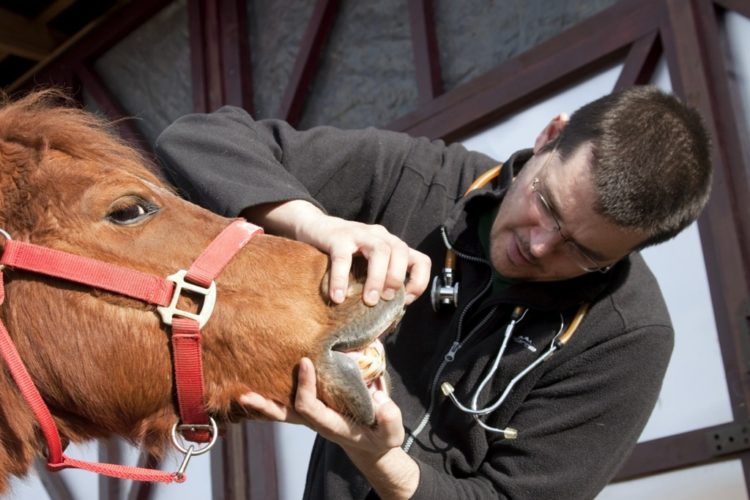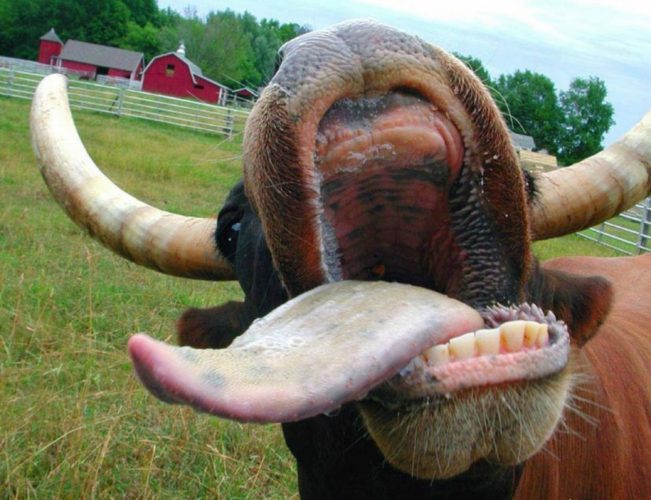Teeth problems in livestock must be addressed in good time, to ensure that the animal is able to eat properly. Most smallholders have a variety of livestock on their plots and it is useful to know about the teeth of these different animals, so that one can watch out for potential dental problems.
All good herdsmen have an on-going interest in the teeth of their animals because they know how important proper chewing is to the livestock’s overall health and productiveness.
People are able to assess the age of an animal from its teeth.
Teeth of Ruminants
Ruminants such as cattle, sheep and goats are herbivores, which means they eat plants, and they have a stomach with multiple chambers. We commonly say that they chew the cud. But what is interesting is that they do not have teeth in the upper jaw, having instead a “dental pad” and their bottom incisors (eight of them) bite against that. This helps them to gather large quantities of grass and other plant matter. However, since they cannot bite grass off, they are inefficient at grazing more closely than 15 cm from the ground.
The temporary incisors of the very young animal are gradually replaced by permanent incisors in pairs, starting with the central pair, then working outwards.
Horses have six incisors on both the upper and lower jaws. The central pair of permanent incisors erupt at about 2½ years of age, the second pair erupt at 3½ years, the fourth pair at 4½ years. As with ruminants, the age of the young horse can be determined by the number of permanent incisors it has.
After 5 years of age, experts use other features of the incisors to help assess age. These features include the pattern of enamel and dentine on the biting surface, the presence of enamel spurs on the outer edges of the third upper incisors, and the angle of the incisors in the jaw.
Pigs are born with incisors and canines, and these teeth eventually grow molars and premolars. Their canines sharpen through the friction of other teeth and tend to be very sharp and dangerous. They typically use their molars, which become irregularly formed over time, to crush their food before ingesting. Pigs are omnivores, which means they eat both plants and animals, and need their canines and molars to chew their food and eat.
Check for teeth problems
When you are making a brief oral examination, it’s very helpful to use a head-light, which leaves both your hands free. It is also good to have someone to hold the animal for you. A thorough examination of the mouth of a large animal may involve the use of a tranquiliser.

Check for excessive incisor wear. With excessive wear, the incisors become short and may be worn down to the level of the gums. This happens when soil or sand on pasture gradually files away at the teeth until they are worn, so it is usually only a problem in older animals.
Livestock with very worn incisors can do well as long as they don’t have to eat very short or stringy pasture. They can be fed long soft pasture or hay or silage or concentrate feed.
Periodontal disease affects the tissues that surround the neck and root of a tooth. In any animal, periodontal disease of the incisors causes them to become long and loose and they may be missing. This is caused by infection around the teeth (periodontitis).
If an animal has only a few very loose incisors, it is probably best to remove them, either with your fingers or with pliers. The animal will then be ‘gummy’, but it can still stay in good body condition if it is offered long soft pasture or hay or silage or concentrate feed. Don’t attempt to remove any teeth that are not already very loose.
Examine the cheek teeth
Check for cheek teeth. Cheek teeth may become unevenly worn, so they don’t grind feed efficiently. This can cause ulcers on the cheeks and tongue. The signs of this include dropping of feed from the mouth while chewing and green staining around the mouth. There might also be bulging of the cheeks caused by wads of food becoming impacted between the teeth and cheek.
Overgrown edges on cheek teeth are common in elderly ponies and horses. Treatment is by rasping the sharp edges. It takes a trained person like a veterinarian or a horse dentist to do this effectively, although some farriers can also do it. To prevent problems, it is wise to have the cheek teeth of ponies and horses rasped annually.
Periodontal disease can affect cheek teeth as well as incisors. It is caused by infections of the gum and supporting structures around the cheek teeth roots. In severe cases the bone becomes swollen and sore, then the animal is reluctant to chew its cud and it gets thin.
If you suspect any problems like this, consult your veterinarian.
Overshot and undershot jaws
Another mouth problem is overshot and undershot jaws. Sometimes animals are born with a lower jaw that is too short. This means that it meets the top pad well behind its front edge, called undershot or “parrot mouth”. Sometimes the lower jaw is too long, i.e. it protrudes, called overshot.
Depending on the severity of the abnormality, the animal may or may not be able to suckle or graze. If the problem is not too bad, the smallholder can still fatten affected calves and lambs for slaughter.
Don’t breed from animals with under- or overshot jaws, as these problems can be hereditary.
Your job is to check your animals’ mouth, but don’t try to be a dentist, as you will be in danger of losing fingers.
Problems with teeth can cause a lot of pain, and they can make eating very difficult. You mustn’t allow animals with painful mouths to suffer and you mustn’t cause unnecessary pain and suffering if you try to treat them yourself.
Consult an expert such as a veterinarian if any of your animals has any significant problems with its teeth.
To read more on livestock click here.
To receive all our notices and each edition of SA Smallholder register here.

